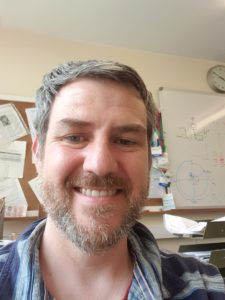 Andy Biggin is Professor of Palaeomagnetism at the University of Liverpool in the UK. He works in the Geomagnetism Lab in the School of Environmental Sciences where he has been since obtaining an Advanced Fellowship from the Natural Environment Research Council (NERC) in early 2009. He got his BSc in geophysics from Liverpool in 1997, his PhD in palaeomagnetism from Kingston (Surrey, not Jamaica) in 2001, and since then has worked as a post-doc in UNAM (Mexico), Montpellier (France), and Utrecht (the Netherlands). Between contracts, he also worked for the Bradford and Bingley financial services company for a couple of years before the big crash (coincidence?). Andy’s research is based around the study of the ancient geomagnetic field through its record preserved in rocks and archaeological materials. He is particularly interested in understanding if, when, and how long term variations in the field’s behaviour tie in with simultaneous changes in conditions in the Earth’s core and mantle.
Andy Biggin is Professor of Palaeomagnetism at the University of Liverpool in the UK. He works in the Geomagnetism Lab in the School of Environmental Sciences where he has been since obtaining an Advanced Fellowship from the Natural Environment Research Council (NERC) in early 2009. He got his BSc in geophysics from Liverpool in 1997, his PhD in palaeomagnetism from Kingston (Surrey, not Jamaica) in 2001, and since then has worked as a post-doc in UNAM (Mexico), Montpellier (France), and Utrecht (the Netherlands). Between contracts, he also worked for the Bradford and Bingley financial services company for a couple of years before the big crash (coincidence?). Andy’s research is based around the study of the ancient geomagnetic field through its record preserved in rocks and archaeological materials. He is particularly interested in understanding if, when, and how long term variations in the field’s behaviour tie in with simultaneous changes in conditions in the Earth’s core and mantle.
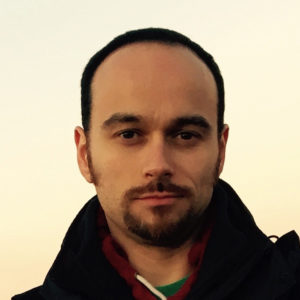 Greig Paterson is a NERC Independent Research Fellow at Liverpool. Greig graduated with a BSc (Hons) in Geophysics from the University of Edinburgh before moving to the University of Southampton for his PhD were he studied the emplacement temperature of pyroclastic deposits and testing their ability to record Earth’s magnetic field. He has since been a post-doc at Kochi University in Japan and Young International Science Fellow at the Institute of Geology and Geophysics, Chinese Academy of Sciences (IGGCAS) in Beijing. Greig stayed in China for more than 7 years becoming an associate Professor at IGGCAS, before moving back to the UK and NERC Fellow. He currently works on a range of magnetic applications, from the fundamental physics of magnetic particle, to understanding the evolution of the geomagnetic field in the past to understanding magnetic life.
Greig Paterson is a NERC Independent Research Fellow at Liverpool. Greig graduated with a BSc (Hons) in Geophysics from the University of Edinburgh before moving to the University of Southampton for his PhD were he studied the emplacement temperature of pyroclastic deposits and testing their ability to record Earth’s magnetic field. He has since been a post-doc at Kochi University in Japan and Young International Science Fellow at the Institute of Geology and Geophysics, Chinese Academy of Sciences (IGGCAS) in Beijing. Greig stayed in China for more than 7 years becoming an associate Professor at IGGCAS, before moving back to the UK and NERC Fellow. He currently works on a range of magnetic applications, from the fundamental physics of magnetic particle, to understanding the evolution of the geomagnetic field in the past to understanding magnetic life.
Simon Lloyd is a Postdoctoral Researcher at the Geomagnetism Laboratory. Simon graduated with a first-class honours degree in Geophysics at the University of Liverpool and continued at Liverpool as a PhD student. Simon’s research has focused on the 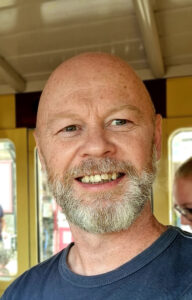 timing of inner core formation and its implications for deep earth processes. His work has involved obtaining robust palaeointensity results from Precambrian (>540 Million years old) rocks that cooled at important time periods in Earth history and integrating these with statistical field analyses. In addition, Simon has developed the methodology of the experimental methods used to acquire these data. More recently, his focus is on slightly younger rocks with the same pursuit. Simons also performs geodynamo simulations that produce long-term field models; these can be used to help determine the deep earth structure of the Earth’s outer core and the amount of thermal and chemical power required to maintain an earth-like palaeomagnetic field.
timing of inner core formation and its implications for deep earth processes. His work has involved obtaining robust palaeointensity results from Precambrian (>540 Million years old) rocks that cooled at important time periods in Earth history and integrating these with statistical field analyses. In addition, Simon has developed the methodology of the experimental methods used to acquire these data. More recently, his focus is on slightly younger rocks with the same pursuit. Simons also performs geodynamo simulations that produce long-term field models; these can be used to help determine the deep earth structure of the Earth’s outer core and the amount of thermal and chemical power required to maintain an earth-like palaeomagnetic field.
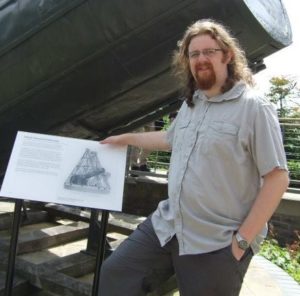 Elliot Hurst is the research technician for the Geomagnetism Laboratory in the School of Environmental Sciences, where he has worked since 2011. He got his BSc in geophysics from Liverpool in 2010, with his dissertation being based in the Geomagnetism Lab, estimating the heating temperature of an archaeological kiln. After working in the banking sector for a year, he was subsequently hired part time as part of a grant with Mimi Hill to perform magnetic measurements as a study of the south-west pacific. Since then he has worked on a variety of projects, including some archaeomagnetic dating studies and most recently as part of Andy Biggin’s DEEP (Determining Earth Evolution from Palaeomagnetism) project, as well as taking on more teaching responsibilities within the department. In his spare time, Elliot enjoys mostly the same things he’s enjoyed his entire life – gaming and Lego – but a few newer hobbies including circus skills performances and improv comedy.
Elliot Hurst is the research technician for the Geomagnetism Laboratory in the School of Environmental Sciences, where he has worked since 2011. He got his BSc in geophysics from Liverpool in 2010, with his dissertation being based in the Geomagnetism Lab, estimating the heating temperature of an archaeological kiln. After working in the banking sector for a year, he was subsequently hired part time as part of a grant with Mimi Hill to perform magnetic measurements as a study of the south-west pacific. Since then he has worked on a variety of projects, including some archaeomagnetic dating studies and most recently as part of Andy Biggin’s DEEP (Determining Earth Evolution from Palaeomagnetism) project, as well as taking on more teaching responsibilities within the department. In his spare time, Elliot enjoys mostly the same things he’s enjoyed his entire life – gaming and Lego – but a few newer hobbies including circus skills performances and improv comedy.
Former members of the team
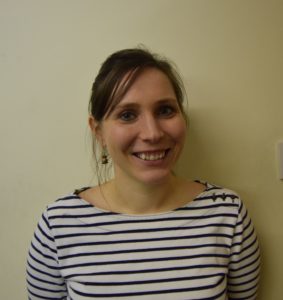 Courtney Sprain (ongoing collaboration) is a geoscientist who operates at the boundary of geophysics and geochemistry to understand the most dramatic events in Earth’s history using both paleomagnetism and 40Ar/39Ar geochronology. She is currently a postdoctoral research associate in the Department of Earth, Ocean and Ecological Sciences at the University of Liverpool working with Andy Biggin. Courtney finished her Ph.D. in the Department of Earth and Planetary Science at the University of California-Berkeley working with Prof. Paul Renne in May 2017. In her research, she is interested in examining the path Earth has taken from its early stages of development to what we see today, investigating changes occurring both within the deep interior and on Earth’s surface. Her research is particularly focused on examining long and short-term trends in Earth’s magnetic field in addition to developing geochronologic constraints for important periods in Earth history. For this work she has utilized an array of analytical techniques including electron microprobe analysis (EPMA), scanning electron microscopy (SEM), X-ray diffraction (XRD), noble gas mass spectrometry, inductively coupled plasma mass spectrometry (ICP-MS), a variety of paleomagnetic and rock magnetic techniques, in addition to numerical geodynamo models.
Courtney Sprain (ongoing collaboration) is a geoscientist who operates at the boundary of geophysics and geochemistry to understand the most dramatic events in Earth’s history using both paleomagnetism and 40Ar/39Ar geochronology. She is currently a postdoctoral research associate in the Department of Earth, Ocean and Ecological Sciences at the University of Liverpool working with Andy Biggin. Courtney finished her Ph.D. in the Department of Earth and Planetary Science at the University of California-Berkeley working with Prof. Paul Renne in May 2017. In her research, she is interested in examining the path Earth has taken from its early stages of development to what we see today, investigating changes occurring both within the deep interior and on Earth’s surface. Her research is particularly focused on examining long and short-term trends in Earth’s magnetic field in addition to developing geochronologic constraints for important periods in Earth history. For this work she has utilized an array of analytical techniques including electron microprobe analysis (EPMA), scanning electron microscopy (SEM), X-ray diffraction (XRD), noble gas mass spectrometry, inductively coupled plasma mass spectrometry (ICP-MS), a variety of paleomagnetic and rock magnetic techniques, in addition to numerical geodynamo models.
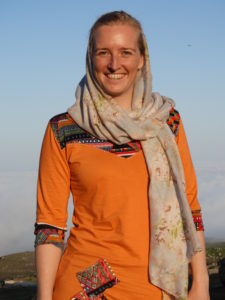 Annique van der Boon (ongoing collaboration) is a postdoctoral research associate in the Geomagnetism lab. After her studies in Earth Sciences at Utrecht University, she pursued a PhD at Paleomagnetic Laboratory Fort Hoofddijk, on the birth of the Paratethys around the Eocene-Oligocene transition. She now works as part of the DEEP Project, on obtaining reversal rates in the Paleozoic (mostly Devonian and Carboniferous) by doing magnetostratigraphy. The results of this study will help to elucidate why there are so few Paleozoic magnetostratigraphic records, and show which areas hold potential for the future. Acquiring reversal rates for the Devonian and Carboniferous will aid in understanding behaviour of the field at times when it was most likely extremely weak. Annique’s interests in Earth Sciences mainly revolve around fieldwork and solving large-scale geologic problems using any available tools. If you need someone to help you in the field in exotic locations, please get in touch. She also likes to do visual outreach by taking videos and pictures during fieldwork, and making things with Adobe illustrator. In her spare time, Annique enjoys being outside, playing golf, surfing, snowboarding and traveling.
Annique van der Boon (ongoing collaboration) is a postdoctoral research associate in the Geomagnetism lab. After her studies in Earth Sciences at Utrecht University, she pursued a PhD at Paleomagnetic Laboratory Fort Hoofddijk, on the birth of the Paratethys around the Eocene-Oligocene transition. She now works as part of the DEEP Project, on obtaining reversal rates in the Paleozoic (mostly Devonian and Carboniferous) by doing magnetostratigraphy. The results of this study will help to elucidate why there are so few Paleozoic magnetostratigraphic records, and show which areas hold potential for the future. Acquiring reversal rates for the Devonian and Carboniferous will aid in understanding behaviour of the field at times when it was most likely extremely weak. Annique’s interests in Earth Sciences mainly revolve around fieldwork and solving large-scale geologic problems using any available tools. If you need someone to help you in the field in exotic locations, please get in touch. She also likes to do visual outreach by taking videos and pictures during fieldwork, and making things with Adobe illustrator. In her spare time, Annique enjoys being outside, playing golf, surfing, snowboarding and traveling.
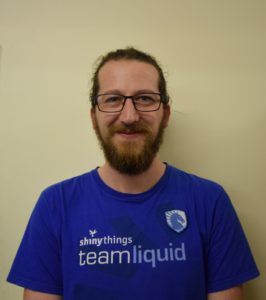 Daniele Thallner (ongoing collaboration) is currently a PhD student in University of Liverpool’s geomagnetism Lab. He did both his BSc in applied geosciences and his MSc in applied geophysics at Montanuniversität Leoben. In this time he worked on geophysical surveys and archaeomagnetic studies of late Roman to early medieval archaeological excavations in central Europe. Now his research focuses on determining the Earth’s magnetic field in the late Neoproterozoic and its implications on the evolution of Earth’s core. To be able to create field models on a global scale, he is currently working on rocks from Canada, Newfoundland and Ukraine. In his free time he tries his best to avoid the gym and enjoys VR gaming, creating game assets in Blender and UnrealEngine and crafting the finest liquors from home-grown ingredients.
Daniele Thallner (ongoing collaboration) is currently a PhD student in University of Liverpool’s geomagnetism Lab. He did both his BSc in applied geosciences and his MSc in applied geophysics at Montanuniversität Leoben. In this time he worked on geophysical surveys and archaeomagnetic studies of late Roman to early medieval archaeological excavations in central Europe. Now his research focuses on determining the Earth’s magnetic field in the late Neoproterozoic and its implications on the evolution of Earth’s core. To be able to create field models on a global scale, he is currently working on rocks from Canada, Newfoundland and Ukraine. In his free time he tries his best to avoid the gym and enjoys VR gaming, creating game assets in Blender and UnrealEngine and crafting the finest liquors from home-grown ingredients.
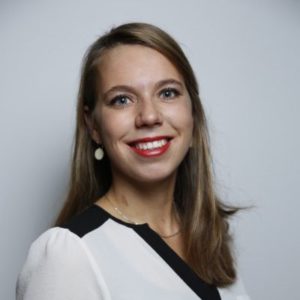 Yael Engbers is a PhD candidate of the Geomagnetism Lab in the School of Environmental Sciences at University of Liverpool. She did her BSc and MSc at Utrecht University in ‘Earth Science’ and ‘Earth Structure and Dynamics’, respectively. Her PhD is about the South Atlantic Anomaly, a patch of low intensity in Earth’s magnetic field over the South Atlantic Ocean. She wants to know if this anomaly is a persistent feature of the magnetic field, and if there is a link to an anomaly on the core-mantle boundary underneath Africa. In January 2018, Andy and Yael visited Saint Helena, an island in the middle of the South Atlantic Ocean, to collect 8-11 million year old rocks. The results on this study will give insight into the behaviour of the magnetic field from that time. These results will be used to construct a new Time Average Field model for the past 12 million years to answer the question: “Is the South Atlantic Anomaly a persistent feature of the Earth magnetic field through time?” Aside from her research Yael enjoys playing various sports, where hockey and sailing are her main priority. She loves going out for a good climb or hike in the mountains and ending the day in the pub with a quality beer (preferably from Belgium) and her friends.
Yael Engbers is a PhD candidate of the Geomagnetism Lab in the School of Environmental Sciences at University of Liverpool. She did her BSc and MSc at Utrecht University in ‘Earth Science’ and ‘Earth Structure and Dynamics’, respectively. Her PhD is about the South Atlantic Anomaly, a patch of low intensity in Earth’s magnetic field over the South Atlantic Ocean. She wants to know if this anomaly is a persistent feature of the magnetic field, and if there is a link to an anomaly on the core-mantle boundary underneath Africa. In January 2018, Andy and Yael visited Saint Helena, an island in the middle of the South Atlantic Ocean, to collect 8-11 million year old rocks. The results on this study will give insight into the behaviour of the magnetic field from that time. These results will be used to construct a new Time Average Field model for the past 12 million years to answer the question: “Is the South Atlantic Anomaly a persistent feature of the Earth magnetic field through time?” Aside from her research Yael enjoys playing various sports, where hockey and sailing are her main priority. She loves going out for a good climb or hike in the mountains and ending the day in the pub with a quality beer (preferably from Belgium) and her friends.
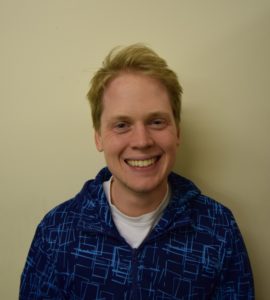 Michael Grappone is a PhD student at The University of Liverpool. He has been working in the Geomagnetism lab since graduating with his BSc in Mechanical Enginering and MSc in Geophysics from the California Institute of Technology in 2016. Michael’s research is funded by The University of Liverpool and the Duncan Norman Research Scholarship. He focuses on prototyping both new equipment and new techniques for paleointensity analysis. He is particularly interested in how the different protocols used affect the final paleointensity estimates because his new equipment will use an uncommonly used technique. Michael is also one of the head Residential Advisors in The University of Liverpool Halls of Residence, where he supervises the Postgraduate Halls Student Committee. In his spare time, ichael enjoys grand strategy video games and playing tennis and squash.
Michael Grappone is a PhD student at The University of Liverpool. He has been working in the Geomagnetism lab since graduating with his BSc in Mechanical Enginering and MSc in Geophysics from the California Institute of Technology in 2016. Michael’s research is funded by The University of Liverpool and the Duncan Norman Research Scholarship. He focuses on prototyping both new equipment and new techniques for paleointensity analysis. He is particularly interested in how the different protocols used affect the final paleointensity estimates because his new equipment will use an uncommonly used technique. Michael is also one of the head Residential Advisors in The University of Liverpool Halls of Residence, where he supervises the Postgraduate Halls Student Committee. In his spare time, ichael enjoys grand strategy video games and playing tennis and squash.
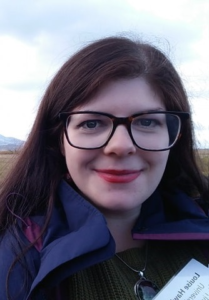 Louise Hawkins is a postdoctoral research associate and former PhD student of the Liverpool Geomagnetism lab. She also completed her undergraduate Masters in Geology at the University of Liverpool before going on to work in the Mineralogy and Core Magnetics departments of CGG Robertson’s in North Wales prior to her PhD. Upon returning to Liverpool, her PhD work focused on defining the strength of the field leading up to the Kiaman Superchron and its relation to long-term patterns in Phaneorzoic field behaviour. The new project “DEEP down under” has her working in Perth, Australia, as well as Liverpool, developing the Proterozoic paleointensity record and fostering collaboration between the Lab and the Earth Dynamics Research Group at Curtin University. Outside of Paleomagnetism, Louise enjoys performing arts and is a keen baker (plan B is to open a bakery if academia doesn’t work out, so watch this space).
Louise Hawkins is a postdoctoral research associate and former PhD student of the Liverpool Geomagnetism lab. She also completed her undergraduate Masters in Geology at the University of Liverpool before going on to work in the Mineralogy and Core Magnetics departments of CGG Robertson’s in North Wales prior to her PhD. Upon returning to Liverpool, her PhD work focused on defining the strength of the field leading up to the Kiaman Superchron and its relation to long-term patterns in Phaneorzoic field behaviour. The new project “DEEP down under” has her working in Perth, Australia, as well as Liverpool, developing the Proterozoic paleointensity record and fostering collaboration between the Lab and the Earth Dynamics Research Group at Curtin University. Outside of Paleomagnetism, Louise enjoys performing arts and is a keen baker (plan B is to open a bakery if academia doesn’t work out, so watch this space).
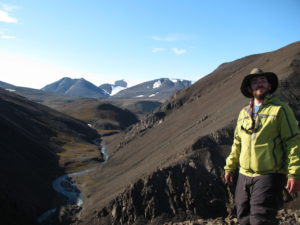 Richard Bono is a Postdoctoral Researcher in the DEEP group (funded by a Leverhulme Trust Research Award). He will be developing statistical palaeomagnetic field models as part of a multidiscplinary team of geophysicists, geologists and dynamo modellers. These statistical models will be used to characterise and test hypotheses related to long term geomagnetic field evolution, along with comparisons to numerical dynamo simulations using Earth-like configurations. He joined the SoES under the supervision of Prof. Andrew Biggin in January 2018 after the completion of his PhD at the University of Rochester, USA, with the Paleomagnetic Research Group. His previous research primarily focused on defining Earth’s palaeomagnetic field during the Precambrian and characterising the magnetic carriers of the ancient geomagnetic field within host rocks.
Richard Bono is a Postdoctoral Researcher in the DEEP group (funded by a Leverhulme Trust Research Award). He will be developing statistical palaeomagnetic field models as part of a multidiscplinary team of geophysicists, geologists and dynamo modellers. These statistical models will be used to characterise and test hypotheses related to long term geomagnetic field evolution, along with comparisons to numerical dynamo simulations using Earth-like configurations. He joined the SoES under the supervision of Prof. Andrew Biggin in January 2018 after the completion of his PhD at the University of Rochester, USA, with the Paleomagnetic Research Group. His previous research primarily focused on defining Earth’s palaeomagnetic field during the Precambrian and characterising the magnetic carriers of the ancient geomagnetic field within host rocks.
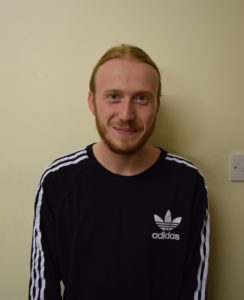 Ben Handford is a PhD candidate in the Geomagnetism Lab at the University of Liverpool, where he previously carried out his final year undergraduate project whilst working towards his BSc in Geophysics. The main focus of his PhD project is to collect palaeointensity data in order to improve the record throughout the Triassic and Late Permian and assess the extent of the proposed Mesozoic Dipole Low, a period of globally low field intensity. This scientific quest took him to the Dolomites, Italy, in September 2018 to collect 237 million year old basalts. With any luck these will provide reliable results, which along with those obtained from a proposed trip to Northern Patagonia in 2019, will result in a clearer view on long-term variations in the Earth’s field strength and its relationship with reversal behaviour. Outside of work hours he spends his time attending a variety of live music events, religiously following his doomed football club, and pretending he can play a bit when he gets the chance.
Ben Handford is a PhD candidate in the Geomagnetism Lab at the University of Liverpool, where he previously carried out his final year undergraduate project whilst working towards his BSc in Geophysics. The main focus of his PhD project is to collect palaeointensity data in order to improve the record throughout the Triassic and Late Permian and assess the extent of the proposed Mesozoic Dipole Low, a period of globally low field intensity. This scientific quest took him to the Dolomites, Italy, in September 2018 to collect 237 million year old basalts. With any luck these will provide reliable results, which along with those obtained from a proposed trip to Northern Patagonia in 2019, will result in a clearer view on long-term variations in the Earth’s field strength and its relationship with reversal behaviour. Outside of work hours he spends his time attending a variety of live music events, religiously following his doomed football club, and pretending he can play a bit when he gets the chance.
Neil Suttie was a postdoctoral researcher also at the Geomagnetism Lab in Liverool. He submitted his PhD thesis on archaeomagnetism and the microwave method in 2010 and is now turning his attention to studies of the more ancient geomagnetic field.

Andy Herries is an Associate Professor and Director of the Australian Archaeomagnetism Laboratory at La Trobe University in Melbourne, Australia. He received a BSc in Archaeological Science in 1997, MSc in Geoarchaeology in 1998 and PhD in Geomagnetism in 2003 from the University of Liverpool (UK). In 2003-2004 he was a Post-doctoral Research Fellow with Mary Kovacheva at the Bulgarian Academy of Sciences in Sofia, Bulgaria; part of the Archaeomagnetic Applications for the Rescue of Cultural Heritage Network (AARCH) directed by Cathy Batt and Don Tarling. In 2005 he moved to Australia as a Post-doctoral Research Fellow at the University of New South Wales. In 2008 he became an Australian Research Council Fellow at UNSW and began setting up his own laboratory. His main field of research has been dating African early hominin fossils using magnetostratigraphy, particularly in caves. He has also undertaken environmental magnetic and sediment source reconstructions of cave sediments, magnetic characterisation of fire use and magnetic sourcing and thermal history reconstructions of archaeological artefacts. He is currently conducting studies of geomagnetic reversal events and excursions combined with isotopic analysis of uranium-lead dated speleothems from Plio-Pleistocene caves. He also runs and participates in archaeological excavations in China, South Africa, Australia, Bulgaria and Kenya. In Bulgaria he continues his Archaeomagnetic studies of Thracian age burnt structures. Andy is an active caver, climber and canyoner and has participated in a number of caving expeditions around the world and often conducts trips and expeditions to explore new caves, recover speleothems for palaeoclimatic reconstruction and conduct rope access work for the excavation of logistically challenging sites.
Laura Roberts-Artal was a PhD student at the geomagentism laboratory at Liverpool University on the project: A Palaeomagnetic Study of 3.2-3.5 Billion Year Old Rocks from South Africa. This project had the overall aim to shed light on early Earth processes, particularly those relating to the early Earth’s magnetic field. Her work is both field and laboratory based and concentrated on samples collected by herself and others, from the Barberton Greenstone Belt, in South Africa. She graduated from Liverpool University with a MESci in Geology in 2007. After her degree, she spent 3 years working for an environmental consultancy as an environmental consultant, working on contaminated land site investigations.
Megan Thomas was a PhD student based in the geomagnetism laboratory at the University of Liverpool. She worked on sharp changes in geomagnetic field intensity and the possible links between field intensity, climate change and the collapse of civilized societies. She is interested in many aspects of geology particularly chemical geology, metamorphic assemblages and palaeontology and graduated from the University of Edinburgh in 2010 with a Masters of Earth Science. In her spare time she plays many sports including Ultimate Frisbee and enjoys reading and socialising.
Emma Hodgson was a PhD student at Liverpool. She completed a 4 year integrated masters, MGeol at University of Plymouth in 2010. She worked on the project ‘Further advances in determination of past geomagnetic field strength using synthetic samples, single crystals and basalt samples from the SW Pacific’ which was part of a larger project aimed at modelling data collected in the Southern hemisphere. Her research area is in intensity of the past magnetic field and the methodology used to obtain it, the project required some field work in New Zealand and Australia.
Andreas Nilsson was employed as a postdoctoral researcher at the University of Liverpool, UK. In 2011 he finished his PhD at Lund University, Sweden, entitled ‘Assessing Holocene and late Pleistocene geomagnetic dipole field variability’. This work was focused on extracting geomagnetic field information stored in lake sediments. His current research concentrates on palaeointensity analyses of both ceramic and volcanic material from the SW pacific and geomagnetic field modelling using a combination of datasets. He is particularly interested understanding the millennial scale evolution of the geomagnetic field focused on the last 10,000 years.
